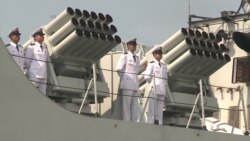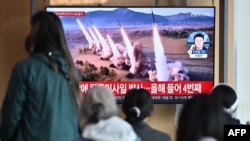ປີ 2017ແມ່ນກຳລັງມີຮູບຮ່າງເປັນປີທີ່ມີຄວາມຫຍຸ້ງຍາກສຳລັບສາຍພົວພັນຂອງກອງທັບ ສະຫະລັດ ໃນພາກພື້ນມະຫາສະໝຸດປາຊີຟິກ. ນັກຂ່າວວີໂອເອປະຈຳທຳນຽບຫ້າແຈ Carla Babb ອະທິບາຍເຖິງສິ່ງທ້າຍທາຍບາງຢ່າງທີ່ມີຢູ່ຂ້າງໜ້າ, ເຊິ່ງ ພຸດທະສອນ ຈະ ນຳລາຍລະອຽດມາສະເໜີທ່ານ.
ມັນເບິ່ງໄດ້ຢ່າງງ່າຍດາຍວ່າ ເປັນຫຍັງປະເທດທີ່ໃຫຍ່ ແລະ ດຸຮ້າຍເຊັ່ນ ຈີນ ຈຶ່ງເປັນໄພ ຂົ່ມຂູ່ ເມື່ອພະຍາຍາມຮັກສາເສັ້ນທາງການເດີນເຮືອຂອງກຳປັ່ນໃຫ້ເປີດຢູ່.
ແຕ່ພວກປະເທດທີ່ນ້ອຍກວ່າຄື ຟີລິບປິນ ແລະ ເກົາຫຼີເໜືອ ແມ່ນກຳລັງສ້າງຄື້ນຟອງໃນ ພາກພື້ນປາຊີຟິກ.
ທ່ານ Michael O’Hanlon ແມ່ນຜູ້ຊ່ຽວຊານຈາກສະຖາບັນ Brookings.
ທ່ານ Michael O’Hanlon ກ່າວວ່າ “ກ່ຽວກັບ ເກົາຫຼີເໜືອ ນັ້ນ, ປະທານາທິບໍດີ ບາຣັກ ໂອບາມາ ຫາກໍໄດ້ເວົ້າກັບທ່ານ ທຣຳ ວ່າ ໂດຍແທ້ຈິງແລ້ວ ນີ້ແມ່ນເປັນອັນຕະລາຍທີ່ ບາງເທື່ອ ຖືກມອງເຫັນໜ້ອຍທີ່ສຸດ.”
ບັນດາຜູ້ຊ່ຽວຊານກ່າວວ່າ ເກົາຫຼີເໜືອ ໄດ້ຜະລິດອາວຸດນິວເຄລຍຫຼາຍເຖິງ 6 ລູກໃນແຕ່ ລະປີ. ເຈົ້າໜ້າທີ່ທະຫານອະວຸໂສຂອງ ສະຫະລັດ ກ່າວວ່າ ປະເທດດັ່ງກ່າວຕອນນີ້ມີ ຄວາມສາມາດທີ່ຈະທຳການໂຈມຕີດ້ວຍອາວຸດພວກນີ້, ແຕ່ຫົວລູກສອນໄຟແມ່ນອາດຈະ ບໍ່ສາມາດໂຈມຕີຖືກເປົ້າໝາຍທີ່ພວກເຂົາເຈົ້າແນ່ໃສ່ໄດ້ເທື່ອ.
ປະເທດ ຟີລິບປິນ, ພັນທະມິດດົນນານຂອງ ສະຫະລັດ ໄດ້ທຳຄວາມພະຍາຍາມເພື່ອຫຼຸດ ການມີສາຍພົວພັນກັບ ສະຫະລັດ ນັບຕັ້ງແຕ່ປະທານາທິບໍດີ ຟີລິບປິນ ທ່ານ Rodrigo Duterte ເຂົ້າດຳລົງຕຳແໜ່ງໃນຕົ້ນປີນີ້ມາ.
ບັນດາເຈົ້າໜ້າທີ່ນາວິກະໂຍທິນ ແລະ ທະຫານເຮືອ ສະຫະລັດ ກ່າວຕໍ່ວີໂອເອວ່າ ພວກ ເຂົາເຈົ້າໄດ້ແລກປ່ຽນການຊ້ອມຮົບປະຈຳປີ ທີ່ໄດ້ເພັ່ງເລັງໃສ່ຄວາມສາມາດໃນການປ້ອງ ກັນທັງທາງບົກ ແລະ ທາງນ້ຳ ດ້ວຍການຝຶກຊ້ອມທີ່ແຕກຕ່າງໃປໃນປີໜ້າ ທີ່ຝຶກຊ້ອມສຳ ລັບການກູ້ໄພພິບັດເທົ່ານັ້ນ.
ແລະ ທະຫານບົກອາດຝຶກຊ້ອມກັບ ຟີລິບປິນ ໃນປີໜ້າເຊັ່ນກັນ, ແລະ ກໍເປັນການຝຶກ ຊ້ອມຄວາມກຽມພ້ອມເພື່ອການຊ່ວຍເຫຼືອດ້ານມະນຸດສະທຳ.
ນານພົນທະຫານບົກ ສະຫະລັດ ທ່ານ Stephen Lanza ກ່າວວ່າ "ຕອນນີ້ພວກເຮົາຍັງ ເຮັດວຽກກັບ ຟີລິບປິນ ຢູ່. ພວກເຮົາອາດຕ້ອງໄດ້ມີການປັບປຸງບາງຢ່າງ ອີງຕາມການ ປະຕິບັດການໃນ ຟີລິບປິນ, ພວກເຮົາໄດ້ກຽມພ້ອມທີ່ຈະເຮັດແລ້ວ.”
ເຖິງແມ່ນວ່າຈະເປັນແນວນີ້ກໍຕາມ, ການມີໜ້າຂອງກອງທັບ ສະຫະລັດ ຢູ່ໃນພາກພື້ນກໍ ຍັງຄົງແຂງແກ່ນຢູ່.
ກອງທັບນາວິກະໂຍທິນ ມີກຳປັ່ນບັນທຸກເຮືອບິນ 4 ລຳໃນພາກພື້ນປາຊີຟິກ.
ກອງທັບບົກໄດ້ດຳເນີນການຝຶກຊ້ອມຮົບຄົບຊຸດ ຮູ້ຈັກກັນວ່າ ເສັ້ນທາງມະຫາສະໝຸດປາ ຊີຟິກ ໄປສູ່ ເກົາຫຼີໃຕ້, ຟີລິບປິນ, ໄທ ແລະ ເປັນເທື່ອທຳອິດກັບປະເທດ ກຳປູເຈຍ.
ນອກນັ້ນຫວຽດນາມ ຍັງໄດ້ເຂົ້າຮ່ວມໃນການຝຶກຊ້ອມໃນອະນາຄົດເຊັ່ນກັນ, ອີງຕາມ ການກ່າວຂອງທ່ານ Lanza.
ນາຍພົນ Lanza ກ່າວວ່າ “ເຈົ້າຢາກໄປຢູ່ຫັ້ນເພື່ອການຍັບຢັ້ງ. ເຈົ້າຢາກໄປຢູ່ຫັ້ນເພື່ອ ຫຼີກ ລ່ຽງຄວາມຂັດແຍ້ງ ແລະ ຢາກຫຼີກລ່ຽງຈາກການຄຳນວນຜິດແທ້ໆ. ແລະ ຂ້າພະ ເຈົ້າຄິດ ວ່າ ການມີໜ້າຂອງພວກເຮົາແມ່ນມີຄວາມສຳຄັນຕໍ່ເສັ້ນແບ່ງສາກົນ. ແລະ ຂ້າພະເຈົ້າຮູ້ວ່າ ຄູ່ຮ່ວມຂອງພວກເຮົາເຫັນຄຸນຄ່າຂອງເລື່ອງທີ່ວ່າພວກເຮົາມີຂໍ້ຜູກ ມັດກັບພວກເຂົາເຈົ້າໃຈມະຫາສະໝຸດປາຊີຟິກ."
ທ່ານກ່າວວ່າ ການຊ້ອມຮົບກັບຫຼາຍປະເທດ ແມ່ນມີຄວາມສຳຄັນໃນການກະກຽມປະ ເທດໃຫ້ເຮັດວຽກຮ່ວມກັນໃນຍາມທີ່ມີອັນຕະລາຍ.
2017 is shaping up to be a complicated year for U.S. military relationships in the Pacific region.VOA Pentagon Correspondent Carla Babb explains some of the challenges in store.]]
It is easy to see why a big, aggressive China is a threat when trying to keep international shipping lanes open.
But smaller countries like the Philippines and North Korea are making big waves in the Pacific region.
Michael O'Hanlon is an expert with the Brookings Institution.
"North Korea, President Obama has just said to Mr. Trump, that this is in fact perhaps the sort of least appreciated danger out there."
Experts say North Korea is building up to a half-dozen nuclear weapons each year.A senior U.S. military official says the country now has the capability to launch these weapons, but the warheads may not yet be able to hit their intended target.
The Philippines, a longtime U.S. ally, has made efforts to reduce ties with the United States since Philippine President Rodrigo Duterte took office earlier this year.
U.S. Navy and Marine officials tell VOA they will swap annual joint exercises that focused on amphibious defense capabilities with a different exercise next year that solely trains for disaster relief.
And the Army may change its training with the Philippines next year as well, again from combat readiness to humanitarian assistance.
U.S. Army Lt. Gen. Stephen Lanza.
"We are still working with the Philippines right now.We may have to make some adjustments based on operations in the Philippines, and we are prepared to do that."
Despite this, the U.S. military presence in the region remains strong.
The Navy has four aircraft carriers in that Pacific region.
The Army is conducting heavy equipment military exercises known as Pacific Pathways with South Korea, the Philippines, Thailand and, for the first time, Cambodia.
Vietnam also has asked to join in a future Pathway exercise, according to Lanza.
"You want to be there to deter. You want to be there to avoid conflict and really to avoid miscalculation.And I think our presence matters forward of the international dateline.And I know that our partners appreciate the fact that we are engaged with them in the Pacific."
He says training in multi-national military exercises is crucial in preparing nations to work together in critical times.










